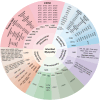Skeletal muscle: molecular structure, myogenesis, biological functions, and diseases
- PMID: 38988494
- PMCID: PMC11234433
- DOI: 10.1002/mco2.649
Skeletal muscle: molecular structure, myogenesis, biological functions, and diseases
Abstract
Skeletal muscle is an important motor organ with multinucleated myofibers as its smallest cellular units. Myofibers are formed after undergoing cell differentiation, cell-cell fusion, myonuclei migration, and myofibril crosslinking among other processes and undergo morphological and functional changes or lesions after being stimulated by internal or external factors. The above processes are collectively referred to as myogenesis. After myofibers mature, the function and behavior of skeletal muscle are closely related to the voluntary movement of the body. In this review, we systematically and comprehensively discuss the physiological and pathological processes associated with skeletal muscles from five perspectives: molecule basis, myogenesis, biological function, adaptive changes, and myopathy. In the molecular structure and myogenesis sections, we gave a brief overview, focusing on skeletal muscle-specific fusogens and nuclei-related behaviors including cell-cell fusion and myonuclei localization. Subsequently, we discussed the three biological functions of skeletal muscle (muscle contraction, thermogenesis, and myokines secretion) and its response to stimulation (atrophy, hypertrophy, and regeneration), and finally settled on myopathy. In general, the integration of these contents provides a holistic perspective, which helps to further elucidate the structure, characteristics, and functions of skeletal muscle.
Keywords: biological function; myogenesis; myonuclear; myopathy; skeletal muscle.
© 2024 The Author(s). MedComm published by Sichuan International Medical Exchange & Promotion Association (SCIMEA) and John Wiley & Sons Australia, Ltd.
Conflict of interest statement
The authors declare that they have no conflict of interest.
Figures





References
-
- Chal J, Pourquié O. Making muscle: skeletal myogenesis in vivo and in vitro. Development. 2017;144(12):2104‐2122. - PubMed
Publication types
LinkOut - more resources
Full Text Sources
